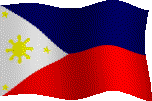|
HISTORY OF FILIPINO CUISINE
excerpted from Katutubong Pinoy
(http://www.geocities.com/NapaValley/6065/history.htm)
More than 300 years ago, long before Spanish conquistadors staggered down their ships to kiss the shores of the islands, Filipinos were rowing out to sea in their little bancas, wading knee-deep in rice paddies, planting in their backyards and hunting in the woods. Whatever they gathered and caught they simply roasted, boiled or broiled over an open fire. The forests were abundant and the surrounding waters teeming with life; the Filipinos' idea of food included everything nature had to offer. Preferably seafood. Preferably fresh. Squirming, leaping, crawling-out-of-the-cooking-pot fresh.
Foreign trade during those times was healthy and a good deal less complicated than today. The Malaysians, Indonesians, Arabians, Indians, and Chinese brought all sorts of spices and food plants to the islands. Some of them stayed and raised families here, and handed down cooking methods which the natives used to improve their own methods.
Filipino cuisine is much like the Filipino himself: a mixture of different cultures, Eastern and Western, that forms one unique culture that is like yet unlike those that preceded it. Throughout the centuries foreigners came, as traders or conquerors, and brought with them their tastes and cooking styles, which the Filipinos adapted to their own essentially Malayan cuisine.
THE CHINESE INFLUENCE
From the Chinese we have the whole noodle business: pancit miki, pancit bihon, pancit Canton, pancit sotanghon. But the Filipinos have completely imbued the dishes with their own flair, and now there is a different kind of pancit for almost every region on the Philippines. Other Chinese-inspired dishes, such as lumpia, kikiam, siopao, and siomai, have been absorbed into the Filipino way of life. They are part of Filipino diet, even today.
THE SPANISH INFLUENCE
Three hundred years of preparing dinner for Mother Spain gave us a flair for rich food, the way Europeans prepare it. Stews such as the cocido and puchero, rice-meat dishes and elaborate desserts such as brazos, and tortas imperiales are generally considered fiesta food, and most often found on the dining tables of the upper classes.
THE AMERICAN INFLUENCE
Sure, they brought us kitchen conveniences like the refrigerator, the pressure cooker, the oven toaster and the microwave. They also gave us burgers, salads, and pies which we baked with native fruits. But though we absorbed so much of their culture in their 50-year colonization, American cooking is only now becoming part of Philippine cuisine. Through their fast-food joints, we indirectly tasted spaghetti and pizza. But somehow we wanted these to taste sweet, not sour as the Italians intended them to be.
|
|


